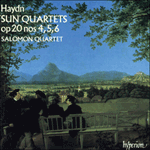
Welcome to Hyperion Records, a British classical label devoted to presenting high-quality recordings of music of all styles and from all periods from the twelfth century to the twenty-first.
Hyperion offers both CDs, and downloads in a number of formats. The site is also available in several languages.
Please use the dropdown buttons to set your preferred options, or use the checkbox to accept the defaults.

| Salomon Quartet» More |
The middle movements of No 6 are, by Haydn’s standards, relatively well behaved. Reverting to the style of the slow movements of Op 9 and Op 17, the E major Adagio cantabile is a soulful aria for first violin, expressively embellished when the first section is repeated, and enriched by dark glints of viola colour. With its gracious succession of four-bar phrases (with the opening phrase repeated to round off the movement—one of Haydn’s beginning-as-ending puns), the minuet is the only one in Op 20 that might, just, be danced. The beautiful, veiled trio is, like that in No 1, literally a trio, though here it is the second violin who is silent while the other three instruments play sotto voce on their lowest string.
from notes by Richard Wigmore © 2011
Les mouvements centraux du no 6 se comportent relativement bien, selon les standards haydniens. Renouant avec le style des mouvements lents des opp. 9 et 17, l’Adagio cantabile en mi majeur est une attendrissante aria adressée au premier violon, expressivement fioriturée à la répétition de la première section et enrichie par de sombres miroitements de couleur à l’alto. Avec sa gracieuse succession de phrases de quatre mesures (la phrase liminaire étant réitérée pour clore le mouvement—une des boutades par lesquelles Haydn prend le début pour une fin), le menuet est le seul de l’op. 20 qui soit vraiment dansable. Comme celui du no 1, le splendide trio voilé est littéralement un trio, même si, ici, c’est le premier violon qui est silencieux, les trois autres instruments jouant sotto voce sur leur corde la plus grave.
extrait des notes rédigées par Richard Wigmore © 2011
Français: Hypérion
Die Mittelsätze von Nr. 6 sind für Haydns Verhältnisse recht brav. Im Rückgriff auf den Stil der langsamen Sätze von op. 9 und op. 17 ist das Adagio cantabile in E-Dur eine gefühlvolle und bei Wiederholung des ersten Abschnitts ausdrucksvoll verzierte Arie für die erste Geige, bereichert vom dunklen Schimmer des Bratschenklangs. Das Menuett ist mit seiner anmutigen Folge von Viertaktphrasen das einzige in op. 20, zu dem man (gerade noch) tanzen könnte. (Eine Wiederholung der Auftaktphrase bringt den Satz dabei zum Abschluss—einer von Haydns Anfang-gleich-Ende-Scherzen.) Das wunderschöne, verschleierte Trio ist wie in Nr. 1 buchstäblich ein Trio, obwohl es hier die zweite Geige ist, die schweigt, während die anderen drei Instrumente Sotto voce auf der tiefsten Saite spielen.
aus dem Begleittext von Richard Wigmore © 2011
Deutsch: Arne Muus
 Haydn: Sun Quartets Nos 4, 5 & 6 Haydn: Sun Quartets Nos 4, 5 & 6‘The Salomon's beautiful playing of these important masterpieces make this set indispensable’ (Gramophone) «Je vous conseillerai de jeter un coup d'oreille sur cette version des Quatuors du Soleil. Elle vaut le détour!» (Répertoire, France)» More |

